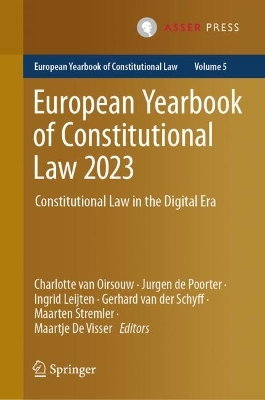Law and Artificial Intelligence
 portes grátis
portes grátis
Law and Artificial Intelligence
Regulating AI and Applying AI in Legal Practice
Custers, Bart; Fosch-Villaronga, Eduard
T.M.C. Asser Press
07/2022
569
Dura
Inglês
9789462655225
15 a 20 dias
1033
Descrição não disponível.
Part I. Introduction.- Chapter 1. Humanizing Machines: Introduction and Overview.- Chapter 2. Artificial Intelligence versus Biological Intelligence: A Historical Overview.- Chapter 3. Disciplines of AI: An Overview of Approaches and Techniques.- Part II. Public Law.- Chapter 4. Discrimination by Machine-based Decisions: Inputs and Limits of Anti-discrimination Law.- Chapter 5. Women's Rights under AI Regulation - Fighting AI Gender Bias through a Feminist and Intersectional Approach.- Chapter 6. Diversity and Inclusion in Artificial Intelligence.- Chapter 7. Artificial Intelligence in Disability Employment: Incorporating a Human Rights Approach.- Chapter 8. Prosecuting Killer Robots: Allocating Criminal Responsibilities for Grave Breaches of International Humanitarian Law Committed by Lethal Autonomous Weapon Systems.- Chapter 9. The Risks of Social Media Platforms for Democracy: A Call for a New Regulation.- Chapter 10. Biased Algorithms and the Discrimination upon Immigration Policy.- Chapter 11. AI in Criminal Law: An Overview of AI Applications in Substantive and Procedural Criminal Law.- Chapter 12. Black-box Models as a Tool to Fight VAT Fraud.- Part III. Private Law.- Chapter 13. Bridging the Liability Gaps: Why AI Challenges the Existing Rules on Liability and How to Design Human-empowering Solutions.- Chapter 14. Contractual Liability for the Use of AI under Dutch Law and EU Legislative Proposals.- Chapter 15. Digging into the Accountability Gap: Operator's Civil Liability in Healthcare AI-systems.- Chapter 16. Automated Care-taking and the Constitutional Rights of the Patient in an Aging Population.- Chapter 17. Generative AI and Intellectual Property Rights.- Chapter 18. The Role and Legal Implications of Autonomy in AI-driven Boardrooms.- Chapter 19. Artificial Intelligence and European Competition Law: Identifying Principles for a Fair Market.- Chapter 20. Personalised Shopping and Algorithmic Pricing: How EU Competition Law Can Protect Consumers inthe Digital World.- Part IV. Legal Practice.- Chapter 21. Lawyers' Perceptions on the Use of AI.- Chapter 22. AI and Lawmaking: An Overview.- Chapter 23. Ask the Data - A Machine Learning Analysis of the Legal Scholarship on Artificial Intelligence.- Chapter 24. The Study of Artificial Intelligence as Law.- Chapter 25. The Right to Mental Integrity in the Age of Artificial Intelligence Cognitive Human Enhancement Technologies.- Chapter 26. Regulating Artificial General Intelligence (AGI).- Chapter 27. Influence, Immersion, Intensity, Integration, Interaction: Five Frames for the Future of AI Law and Policy.- Index.
Este título pertence ao(s) assunto(s) indicados(s). Para ver outros títulos clique no assunto desejado.
Artificial Intelligence;Robots and Autonomous Systems;Lawmaking;Automated decision-making;Cyber-physical Systems;Liability and Responsibility;Meaningful control;Human Rights;Big Data;Diversity and Inclusion
Part I. Introduction.- Chapter 1. Humanizing Machines: Introduction and Overview.- Chapter 2. Artificial Intelligence versus Biological Intelligence: A Historical Overview.- Chapter 3. Disciplines of AI: An Overview of Approaches and Techniques.- Part II. Public Law.- Chapter 4. Discrimination by Machine-based Decisions: Inputs and Limits of Anti-discrimination Law.- Chapter 5. Women's Rights under AI Regulation - Fighting AI Gender Bias through a Feminist and Intersectional Approach.- Chapter 6. Diversity and Inclusion in Artificial Intelligence.- Chapter 7. Artificial Intelligence in Disability Employment: Incorporating a Human Rights Approach.- Chapter 8. Prosecuting Killer Robots: Allocating Criminal Responsibilities for Grave Breaches of International Humanitarian Law Committed by Lethal Autonomous Weapon Systems.- Chapter 9. The Risks of Social Media Platforms for Democracy: A Call for a New Regulation.- Chapter 10. Biased Algorithms and the Discrimination upon Immigration Policy.- Chapter 11. AI in Criminal Law: An Overview of AI Applications in Substantive and Procedural Criminal Law.- Chapter 12. Black-box Models as a Tool to Fight VAT Fraud.- Part III. Private Law.- Chapter 13. Bridging the Liability Gaps: Why AI Challenges the Existing Rules on Liability and How to Design Human-empowering Solutions.- Chapter 14. Contractual Liability for the Use of AI under Dutch Law and EU Legislative Proposals.- Chapter 15. Digging into the Accountability Gap: Operator's Civil Liability in Healthcare AI-systems.- Chapter 16. Automated Care-taking and the Constitutional Rights of the Patient in an Aging Population.- Chapter 17. Generative AI and Intellectual Property Rights.- Chapter 18. The Role and Legal Implications of Autonomy in AI-driven Boardrooms.- Chapter 19. Artificial Intelligence and European Competition Law: Identifying Principles for a Fair Market.- Chapter 20. Personalised Shopping and Algorithmic Pricing: How EU Competition Law Can Protect Consumers inthe Digital World.- Part IV. Legal Practice.- Chapter 21. Lawyers' Perceptions on the Use of AI.- Chapter 22. AI and Lawmaking: An Overview.- Chapter 23. Ask the Data - A Machine Learning Analysis of the Legal Scholarship on Artificial Intelligence.- Chapter 24. The Study of Artificial Intelligence as Law.- Chapter 25. The Right to Mental Integrity in the Age of Artificial Intelligence Cognitive Human Enhancement Technologies.- Chapter 26. Regulating Artificial General Intelligence (AGI).- Chapter 27. Influence, Immersion, Intensity, Integration, Interaction: Five Frames for the Future of AI Law and Policy.- Index.
Este título pertence ao(s) assunto(s) indicados(s). Para ver outros títulos clique no assunto desejado.







